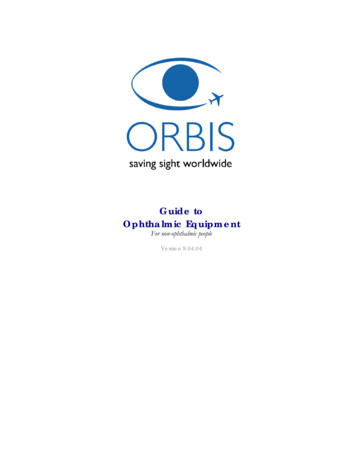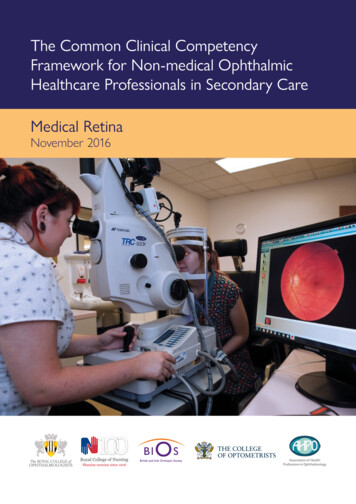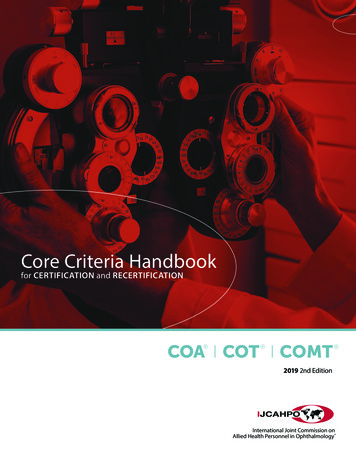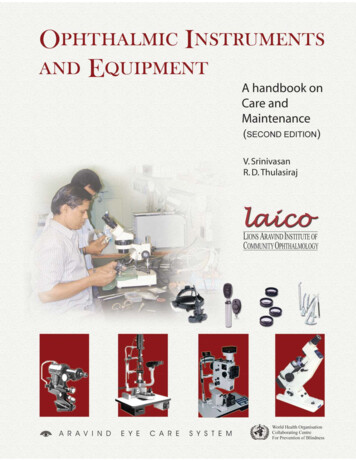
Transcription
Guide toOphthalmic EquipmentFor non-ophthalmic peopleVersion 9.04.04
ORBISGuide to Ophthalmic Equipment2IntroductionOphthalmologists and other eye care professionals use many devices to diagnose and treat eyeproblems. This guide introduces some of the more commonly used devices and is mainly writtenfor persons who are not eye care professionals wishing to know what each device looks like and tounderstand how it is used.Part I will review some of the common devices used for examination and diagnosis. Part II willreview devices used for the treatment of eye problems.*Note: All prices mentioned in this guide are in US dollars and represent typicalprices paid by US hospitals for equipment made in the US, Europe and Japan.Actual prices will depend on brand, model, discounts, desired features, purchaselocation, number of devices purchased, etc.General Financial and Management Considerations for OwningMedical EquipmentIn addition to its original purchase price, medical equipment costs money tooperate and to maintain during its life cycle. Installation of certain equipmentsuch as some lasers will involve initial additional costs for dedicated water andelectrical supplies. Expensive consumables, which generally are not re-usable,are required for devices such as phaco machines and vitrectomy machines. Allmedical devices, regardless of their complexity and ruggedness, requireperiodic maintenance and corrective maintenance at some point. Even asimple device such as an ophthalmoscope requires ongoing costs forreplacement of bulbs and batteries, including rechargeable ones.As a rule, equipment owners should budget anywhere from 5% to 10% of thepurchase cost per year for each device for consumables, parts, maintenance,and user training. The life cycle of a medical device can range between 5 and15 years, depending on the ruggedness of the device and the environment inwhich it is used.All eye care institutions should have a medical equipment managementprogram to assure the maximum and most cost effective utilization of itstechnology. This equipment management program may, depending on theavailable resources and capacity of the institution, be handled by an in-housebiomedical engineering department, by an outside service organization, or byan equipment maintenance service shared by several linked institutions. Thisprogram should include equipment inventory, preventive maintenance,corrective maintenance, emergency repair services, technology planning(including selection, procurement and retirement of equipment), training forequipment users and patient safety, among other functions.Version 06-29-04
ORBISGuide to Ophthalmic EquipmentGeneral Considerations for Maintaining Ophthalmic EquipmentMost ophthalmic diagnostic devices have optical components such as lenses,mirrors, and prisms. Many of these components have a special thin coating forfiltering specific wavelengths of light, for reflecting light, or for reducing reflection.Great care must be exercised when removing dust and stains on opticalcomponents to avoid scratching or removing the surface coating. Dust and stainsbecome harder to clean when they accumulate and therefore periodic cleaningis recommended. However, excessive cleaning can lead to quick deterioration ofthe surface coating. Specific manufacturer instructions for frequency and methodof cleaning should be followed for each device. All ophthalmic equipmentshould be kept under dust covers when not in use.In regions with hot and humid climates, it is very common for fungus to grow onoptical components such as lenses and mirrors. In its first stages, fungus would notbe perceivable by the clinician. With time the fungus covers the lens surface in aweb like manner. Initially there will be a very slight loss of image brightness,followed by decreased contrast due to light reflecting off the fungus. In its finalstages, the fungus etches the outer coatings of the lens and image sharpnessdeteriorates. Removing fungus from lenses is extremely difficult and rarely yieldsgood results. Ultraviolet radiation (sunlight or an ultraviolet lamp) or paraldehydemay be used to kill fungus. Once killed, the fungus may be easier to remove butthe outer coatings of the lens will most likely have irreversible damage. Opticsshould be kept in a dry place with plenty of air circulation to prevent fungusgrowth. Air conditioners and dehumidifiers are very helpful in preventing fungusgrowth but if not available, the optics can be kept in a sealed container withpackets of desiccant such as silica gel.Bulbs are common in most ophthalmic devices. When replacing bulbs, careshould be taken to not touch them with bare fingers. Oils from the skin create hotspots on the bulb that can shorten the bulb’s life. Additionally, fingerprints canbecome etched into the bulb’s glass jacket and cause a shadow on theillumination field.Any maintenance that involves precise alignment of optics, or calibration ofpotentially dangerous forms of energy such as laser energy, should only beperformed by manufacturer representatives or by qualified factory-trainedpersonnel. The level of serviceability in the hospital for any device depends on theequipment design, the technology used, the level of support provided by themanufacturer, the available tools and test equipment, and the skills and trainingof the institution’s biomedical equipment personnel.All maintenance personnel must follow protective measures when testing andrepairing lasers in order to reduce the possibility of exposure of the eye and skin tohazardous levels of laser radiation. One important measure is the use of properlaser safety glasses designed to filter the specific wavelengths and power of thelaser being used. Lasers should not be used or tested in the presence offlammable anesthetics or other volatile substances or materials because of theserious risk of explosion or fire.Version 06-29-043
ORBISGuide to Ophthalmic EquipmentPart I- Equipment for Examination, Diagnosis and MeasurementDirect OphthalmoscopeA direct ophthalmoscope is a hand-held instrument for routineexamination of the inside of the eye. It contains a battery, avariable light source, and a set of lenses used to focus on particularstructures of the eye. The device is held in front of the patient'seye and the operator looks through one of the small lenses intothe eye to view the appearance of the cornea, the lens, the aqueousand vitreous humor, and the surface of the retina. The viewprovided by the ophthalmoscope is monocular, non-stereoscopic(2D), narrow field (5 ), and is magnified about 15X.doctorpatient’s eyeTypical Price *: 250-600Popular Manufacturers*: Heine, Welch AllynVersion 06-29-044
ORBISGuide to Ophthalmic Equipment5Indirect OphthalmoscopeA binocular indirect ophthalmoscope (BIO) is wornas a headset and is used in conjunction with acondensing aspheric lens held close to the patient’seye. A BIO provides a much wider field of view(45 ) than a direct ophthalmoscope and permitsviewing of almost all the patient’s retina. The BIO isthe viewing instrument of choice for retinalexaminations. The view provided by the BIO isstereoscopic (3D), inverted, and illuminated withmagnification of about 5X. Some BIOs have a builtin video camera to permit eye care professionals intraining to view the examination on a screen.headsethand-heldlens 60mmlightsource 15mmdoctorTypical Price *: 1,000 to 2,000. 10,000 for video modelsPopular Manufacturers*: Heine, Keeler, Welch AllynVersion 06-29-04patient’s eye
ORBISGuide to Ophthalmic Equipment6Slit LampA slit lamp is a device designed specifically forexamination of the external and internal anteriorstructures of the eye. Eye care professionals use slitlamps to identify diseases, spot foreign bodies, fitcontact lenses, and visualize surgical laserprocedures. The slit lamp is composed of amicroscope and a light source. The microscope isbinocular, stereoscopic and has variousmagnification settings ranging from 6x to 40x. Aspecial stage allows for a wide range of movementof the microscope and positioning of the patient.The light source is the feature that makes thisinstrument so specific for examining the eye. The beam of light can be changed in intensity, height,width, direction, angle, and color. Most examinations are performed with the light beam set atmaximum height and narrow width thereby producing a slit of light, hence the name slit lamp.Some slit lamps have attachments for video cameras or digital still cameras for photographicdocumentation and telemedicine applications.light sourcedoctorpatient’s eyemicroscopeTypical Price *: 2,000-13,000Popular Manufacturers*: Zeiss, Haag Streit, Marco, TopconVersion 06-29-04
ORBISGuide to Ophthalmic Equipment7TonometerThe eye maintains a fairly constant internal pressure tosupport its shape. This is known as intraocular pressure(IOP). The normal range of intraocular pressure isbetween 10 and 20 mmHg. Ophthalmic professionalsuse tonometers to measure IOP. An elevated IOP mayindicate glaucoma.Tonometers come in three main types: Applanation,Non-contact and Schiotz. Applanation tonometersmeasure the force that is required to flatten the corneain mmHg. They require the use of fluorescein dye andthe cornea needs to be anesthetized. Most applanationtonometers come mounted on slit lamps. Non-contacttonometers obtain IOP without touching the eye and do not require anesthesia. The readings aretaken after a soft puff of air is directed at the patient’s eye and the resulting corneal deformity ismeasured and converted to pressure. The Schiotz tonometer is a simple portable metallic device andis generally used in operating rooms. It consists of a footplate that is placed on the cornea and acentral movable plunger that is fitted into a barrel. Attached to the plunger is a needle and scale formeasurement. The reading on the scale is converted to mmHg by using a conversion card.FF IOPTypical Price *: 1,200 to 6,000Popular Manufacturers*: Medtronic Xomed, Haag Streit, PerkinsVersion 06-29-04
ORBISGuide to Ophthalmic EquipmentPhoropterThe phoropter, also called refractor, is a largeand strange looking pair of glasses containingmany lenses that can reproduce virtually anypossible optical correction. The patient sits in achair and looks into the phoropter, and views aneye chart approximately 20 feet away. Theexaminer moves different lenses in front of eacheye, and asks the patient whether the vision isbetter or worse. The examiner can then makesmall increments of correction to establish thebest-suited lens powers for the patient’s glasses.Typical Price *: 2,000- 6,000Popular Manufacturers*: Reichert, Topcon, MarcoKeratometerThe Keratometer measures the curvature of the anteriorcentral zone of the cornea, which is the chief refractingsurface of the human eye. Measurements are made either inmillimeters radius of curvature or in diopters. Thesemeasurements known as K readings are used for fittingcontact lenses, evaluating corneal astigmatism and forcalculating intraocular lens (IOL) power.Typical Price *: 1,200-10,000Popular Manufacturers*: B&L, ReichertVersion 06-29-048
ORBISGuide to Ophthalmic Equipment9Diagnostic UltrasoundUltrasonography involves the use of reflected sound wavesfrom tissue interfaces to draw an acoustic picture of astructure. Ultrasonic scanners are used in ophthalmology intwo modes: A mode and B mode (also known as A-scan andB-scan respectively).In A mode they measure the axial length of the eye. The eyemeasures between 21 and 26 mm in length. Thismeasurement is used for calculating the power of the IOLthat should be implanted after the removal of a cataract.In B mode they provide a two dimensional image of theinterior structures of the eye which permits detection ofretinal detachments, foreign bodies and tumors. This isespecially useful when the light path of the eye is obstructed by a cloudy cataract or by blood in thevitreous, for instance, and viewing the interior of the eye cannot be accomplished usingconventional optical instruments. Some of the most recent models of B-scan machines havesoftware that assembles 3D images.Cornea LensRetinaA-scanB-scanCorneaLensRetinaTypical Price *: 5,000 to 15,000 for A-scan, 10,000 to 35,000 for A/B-scanPopular Manufacturers*: Quantel Medical, Alcon, Sonomed, and OTIVersion 06-29-04
ORBISGuide to Ophthalmic Equipment10Fundus CameraA fundus camera, also know as retinal camera, is aninstrument designed for taking pictures of the backof the eye, or fundus. These images are used todocument ocular conditions (e.g., glaucoma,diabetes, hypertension, etc.). In the case of diabeticretinopathy, fundus photography documentationhelps the doctor keep a database of the progressionof the disease and facilitate its management andcontrol. The camera is often used in fluoresceinangiography, a test where fluorescein dye is injectedinto a patient and a fundus camera is used to takepictures of the retina to reveal retinal circulation.A fundus camera is a specialized low powermicroscope with an attached camera. Its optical design is based on the indirect ophthalmoscope.The retina can be photographed directly since the pupil is used as both an entrance and exit for thefundus camera's illuminating and imaging light rays. The patient sits at the fundus camera withtheir chin in a chin rest and their forehead against the bar. An ophthalmic photographer focusesand aligns the fundus camera. A flash fires as the photographer presses the shutter release, creatinga fundus photograph.Many current fundus cameras can produce retinal images indigital form, providing a host of uses that greatly expandstheir value. With film-based cameras, there is the ongoingcost of the film and it’s processing. This limits their use toonly the “essential” diagnostic needs while digital funduscameras can be used as often as desired and can be interfacedwith a computer for storage of the retinal images as graphicfiles. These files can then be archived, edited, printed or sentto other eye care specialists through a local computer networkor over the ent’s eyefocuslight sourceTypical Price *: 15,000 to 60,000Popular Manufacturers*: Canon, Topcon, Kowa, ZeissVersion 06-29-04camera
ORBISGuide to Ophthalmic Equipment11Part II- Equipment for TreatmentOperating MicroscopeEye surgeons use operating microscopes forprocedures that require high magnification and variablefocusing. The operating microscope has features suchas pedal-controlled motorized focusing, motorizedzoom magnification, and motorized lateral andlongitudinal (x-y) positioning. These allow the surgeonto concentrate on the surgery rather than onmanipulating the microscope.A set of articulated arms connects the microscope headassembly to a mobile floor stand, wall mount, or ceilingmount. The lens system consists of eyepiece lenses,magnification lenses, and objective lenses. The magnification of operating microscope eyepieces istypically 8X to 20X. Objectivelenses are described by theirworking distance or focal length,which is the focused distancefrom the objective lens to theviewed object. The typical focallength of objective lenses for eyesurgery using a 12.5X eyepiece is175 to 200 mm.Light from a halogen lightsource is directed into the tubethrough prisms or fiber opticcables and shines through theobjective lens onto the operatingfield. The light beam is reflectedfrom the operating field throughthe objective lens and themagnification changer drum tothe eyepieces. The surgeon canthen see the image of theoperating field. A beam splitterallows the image to be directedthrough prisms to photographicor video cameras, or to a secondeyepiece set for an assistantsurgeon.Typical Price *: 5,000 to 80,000Popular Manufacturers*: Zeiss, Topcon, Leica,Version 06-29-04
ORBISGuide to Ophthalmic Equipment12Phacoemulsification MachineA cataract is a cloudy eye lens. This conditioncan be caused by several factors: environment,diseases, drugs, aging, trauma, genetic defects, orbirth defects. Age-related cataracts are the mostcommon. Cataracts hinder the transmission oflight to the retina, causing blurry vision. Ifuntreated, the patient will experience progressivevision loss leading to blindness.Phacoemulsification is a technique whereultrasonic energy, ranging from about 25 to80Khz, is used to break up the opaque lens intosmaller pieces that are then aspirated out of the eye. After the entire cataract is removed, anintraocular lens (IOL) is inserted in place of the eye’s lens. Many ophthalmic surgeons use thistechnique since the procedure can be done through one small incision, which does not requiresutures. This helps reduce surgically induced astigmatism, decrease surgical complications such asinfection, and accelerate visual rehabilitation. Phacoemulsification is performed with the aid of anoperating microscope.The main components of a phacoemulsification machine are the ultrasonic (US) system and theirrigation/aspiration (I/A) system. The surgeon controls these systems by actuating a singlefootpedal. Front-panel controls are used to select ultrasonic power levels, vacuum limits, irrigationrate, and other parameters.Sterile saline solution hung from a variable height IV pole is used as an irrigant. The irrigation lineruns from the bottle through a pinch valve. When this valve opens, fluid flows into the eyethrough an irrigation sleeve that surrounds the tip of the US handpiece. The surgeon prevents theanteriorchamber of theaspirationeye fromcollapsing byultrasoundadjusting theirrigation flowaccording tothe fluid lossirrigationpatient’s eyeresulting fromaspiration.The aspirationline runs fromthe handpieceto a vacuum pump through a collection container. Aspiration is used to hold the lens nucleus andlarger fragments to the US tip, where they can be emulsified. Smaller fragments of lens and irrigantare then suctioned into a collection canister. Aspiration and irrigation also aids in cooling the USprobe tip by moving fluid. I/A systems commonly use peristaltic, diaphragm, or venturi pumps tocreate suction.Many phacoemulsification machines contain components for other facets of cataract surgery suchas anterior vitrectomy for removing vitreous, and bipolar diathermy for controlling bleeding.handpiece tipVersion 06-29-04
ORBISGuide to Ophthalmic Equipment13It is common to see phacoemulsification and vitrectomy machines integrated into a single system.IV Fluidhandpiececollection canisterfootswitchTypical Price *: 15,000 to 100,000Popular Manufacturers*: Alcon, Bausch & Lomb, Oertli, AMOVersion 06-29-04OscillatiSignal ononAspiratigaIrriControlstionRoller Pump
ORBISGuide to Ophthalmic Equipment14Vitrectomy MachineVitreous is a clear, jelly-like substance that fills the inside of the eye.Since vitreous is normally clear, light rays are able to travel through itand reach the retina. However, any variation in the consistency, coloror structure of the vitreous can hinder transmission of light to theretina, affecting vision. Vitrectomy is a procedure in which the surgeonremoves cloudy vitreous from the eye and replaces it with a clearsolution. Light can then pass through this clear fluid, restoring normalsight.A vitrectomy is performed with the aid of an operatingmicroscope and a contact lens that is placed on the patient’scornea. This allows a clear view of the vitreous cavity andretina at various magnifications. Vitrectomy machines havethe following main functions: vitreous cutting, irrigation,aspiration, and illumination.Cutting the vitreous is accomplished by a small handpiececontaining a guillotine, oscillating or rotating cutter. Pulsesof compressed air mechanically actuate the cutter. Somevitrectomy machines require connection to an externalcompressed air source, while others have an internal pump.Cutting is performed in the adjustable range of 60 to 2000cuts per minute.cuttingThe sliced vitreous isaspirated through thehandpiece, which issuctionsuctionvitreousconnected to a suction linecuttingthat carries the fragments to amechanismcollection canister. Aspirationpatient’s eyesystems commonly useperistaltic, diaphragm, orventuri pumps. An irrigation line runs from an IV bottle with sterile saline solution through apinch valve to the handpiece. When the pinch valve opens, fluid flows into the eye.A light probe that is inserted through a tiny incision in the eye provides illumination for theprocedure. The light probe is coupled via a fiber optic cable to a high intensity halogen light sourcehoused inside the machine.The surgeon controls the vitrectomy machine using a footpedal. Front-panel controls are used toselect cutting rates, vacuum limits, irrigation rate, light intensity and other parameters. It iscommon to see phacoemulsification and vitrectomy functions integrated into a single machine.Typical Price *: 15,000 to 100,000Popular Manufacturers*: Alcon, Bausch & Lomb, Oertli, AMOVersion 06-29-04
ORBISGuide to Ophthalmic Equipment15Cryo Surgical UnitCryosurgery is the use of extreme cold to treat a variety ofconditions. In ophthalmology, cryosurgery is used to treatconditions such as retinal detachment, trichiasis (ingrowneyelashes), glaucoma and cataract extraction among others.Cryo surgical units (CSU) apply a refrigerant (cryogen) towithdraw heat from target tissue through contact with acryogen-cooled probe. The effect is to freeze thesurrounding tissue so that it dies. In the tissue immediatelybeyond the killed zone a degree of coagulation occurs thus limiting the resulting bleeding. Thesurgeon controls the freezing by activating a pedal that releases the cryogen from a pressurizedtank into the probe. Compressed nitrous oxide (N2O) and carbon dioxide (CO2) are used ascryogens in ophthalmology. When these gases expand into the probe, they cause the tip of theprobe to cool. The lowest probe-tip temperatures that can be attained with these gases are -89 and -79 C, respectively. A variety of interchangeable probes with different tip sizes and shapes areavailable for specific types of surgery.Ophthalmic cryosurgery is used for cataract removal in developingcountries, but its use in developed countries has decreased over thepast decade. Intracapsular Cataract extraction (ICCE) has beenreplaced by extracapsular extraction, using either phacoemulsificationor irrigation/aspiration techniques that leave the posterior lens capsuleintact and allow implantation of a prosthetic lens behind the iris;cryosurgical reattachment of the retina has been supplanted by laserphotocoagulation and other techniques. However, cyclocryotherapy(freezing of the ciliary body to reduce ciliary process secretion ofaqueous humor, thereby lowering interocular pressure and haltingdamage to the ocular nerve) is still being used to treat advanced casesof open-angle glaucoma in patients with limited functional vision, andcryosurgery is the preferred method of treatment for trichiasis andbasal cell carcinomas of the lid and periocular region because it yieldssuperior cosmetic results. Cryosurgery is also used experimentally inthe treatment of corneal herpes (herpetickeratitis) and retinopathy in premature infants.Typical Price *: 3,000 to 12,000Popular Manufacturers*: Keeler, Cooper Surgical, ErbeVersion 06-29-04
ORBISGuide to Ophthalmic Equipment16Ophthalmic LasersOphthalmic lasers allow precise treatment of arange of eye problems with little risk of infection.Many laser procedures are relatively pain free andcan be performed on an outpatient basis. Thecombination of safety, accuracy, and relative lowcost, make lasers very useful ophthalmic tools.The word Laser is an acronym for lightamplification by stimulated emission of radiation.Laser light is coherent (wavelengths are in phase inspace and time), monochromatic (one color orwavelength), and collimated (light is emitted as anarrow beam in a specific direction). Laser beamsare produced by the excitation of atoms to a higher than usual energy state. Laser radiation isemitted as the atoms return to their original energy levels.The main components of a laser system are the laser tube, the pump or excitation source, thepower supply, and a cooling unit. Laser energy is delivered to eye structures using one of severaldelivery systems: endoprobe (a small fiber optic probe that is inserted into the eye), slitlamp,operating microscope and indirect ophthalmoscope.Different types of lasers emit specific wavelengths of light and are used to treat specific eyeproblems. Lasers are usually named according to the active material used. For instance, an argonlaser contains argon gas as its active material, while the YAG laser contains a solid material madeup of yttrium, aluminum, and garnet. The effects that lasers have on eye tissues are both a functionof the molecular composition of the tissue and the wavelength and power of the laser light.The argon laser emits blue-green wavelengths, which are absorbed by the cells under the retina andby the red hemoglobin in blood. However, blue-green wavelengths can pass through the fluidinside the eye without causing damage. For this reason, the argon laser is used extensively in thetreatment of diabetic retinopathy, a severe disorder of the retina that causes blood vessels to leak.The argon laser can burn and seal these blood vessels. Retinal detachment is another serious eyeproblem that can be treated by the argon laser. The laser is used to weld the detached retina to theunderlying choroid layer of the eye. Some forms of glaucoma, a leading cause of blindness, mayalso be treated with argon lasers. For instance, angle closure glaucoma can be treated by using anargon laser to create a tiny hole in the iris, allowing excess fluid inside the eye to drain to reducepressure. Macular degeneration, a severe condition that affects central vision in older people, issometimes treated with an argon or krypton laser. In this treatment, the laser is used to destroyabnormal blood vessels so that hemorrhage or scarring will not damage central vision.The YAG laser generates short-pulsed, high-energy light beams to cut, perforate, or fragmenttissue. This laser may also be called a neodymium-YAG or ND-YAG laser. Many people have themisconception that a YAG laser is used to remove cataracts. This misunderstanding happensbecause up to two thirds of cataract patients develop a condition known as posterior capsularopacification, a clouding of the lens capsule months after cataract surgery. This gradual loss ofvision is similar to the symptoms of a cataract, causing people to believe that their cataract hasreturned. The YAG laser is commonly used to vaporize a portion of the capsule, allowing light toVersion 06-29-04
ORBISGuide to Ophthalmic Equipmentcapsulotomy17fully reach the retina. The YAG laser can also beused to treat angle closure glaucoma by creating atiny hole in the iris, a capsulotomy, allowing excessfluid inside the eye to drain to reduce pressure.The Diode laser has similar applications to both theargon and the YAG laser. The advantage of diodelasers is that they are more portable, produce lessheat, and require much less maintenance thanother types of lasers.The Erbium laser has a high absorption rate in water, a main component of the eye's lens. For thisreason it is currently being assessed as an alternative to phacoemulsification for the removal ofcataracts. The Erbium laser is also used in removal of skin wrinkles.The Excimer laser is used in refractive correction surgery known as laser in-situ keratomileusis(LASIK). Excimer lasers emit ultraviolet light,vaporizing tissue by breaking down moleculartissue bonds in a miniscule area. It is called a coldlaser because it does not produce heat withharmful effects to the surrounding tissue. Theexcimer laser is precise and each pulse of the laserremoves about 1/500 of the thickness of a humanhair. Its precise control over depth and area ofremoved tissue is useful for reshaping the corneafor correction of refractive errors.The Holmium laser is used in a refractive surgery procedure known as laser thermal keratoplasty.This procedure corrects mild to moderate cases of farsightedness and some cases of astigmatism.The Holmium laser does not reshape the cornea by removing tissue as the Excimer laser does.Instead it reshapes the cornea by producing infrared light that causes the tissue to shrink. Thepulsations from the Holmium laser produce a pattern of 8 to 16 tiny beams in concentric ringsaround the periphery of the cornea. The heated fluid in the spots where these beams hit the corneacreates a series of tiny craters. The shrinking pulls in the periphery of the cornea, causing thecenter to bulge and as a result correcting farsightedness.Clinical personnel must follow protective measures in order to reduce the possibility of exposureof the eye and skin to hazardous levels of laser radiation. One important measure is to wear theproper laser safety glasses designed to filter the specific wavelengths and power of the laser beingused.Typical Price *: 25,000 to 600,000Popular Manufacturers*: Alcon, Lumenis, Zeiss, IridexVersion 06-29-04
ORBISGuide to Ophthalmic EquipmentAPPENDIX- Diagram of the EyeVersion 06-29-0418
ORBIS Guide to Ophthalmic Equipment 2 Introduction Ophthalmologists and other eye care professionals use many devices to diagnose and treat eye . emergency repair services, technology planning (including selection, procurement and retirement of equipment), training for equipment users and patient safety, among other functions.










